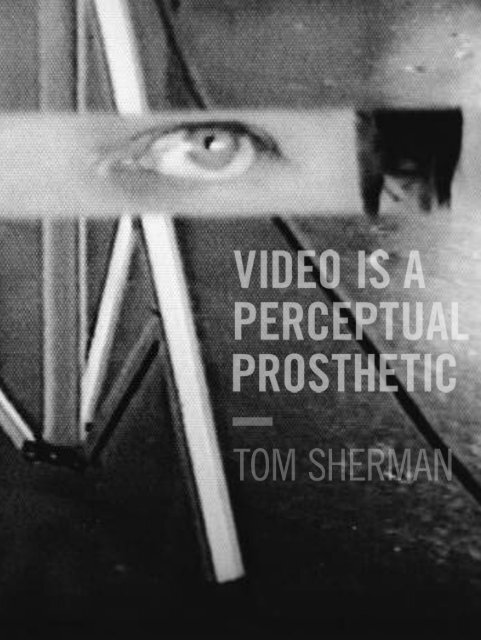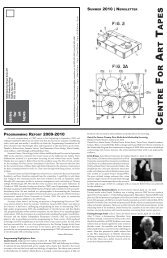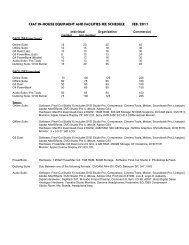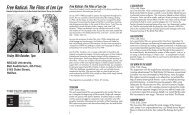video is a perceptual prosthetic - Centre for Art Tapes
video is a perceptual prosthetic - Centre for Art Tapes
video is a perceptual prosthetic - Centre for Art Tapes
Create successful ePaper yourself
Turn your PDF publications into a flip-book with our unique Google optimized e-Paper software.
VIDEO IS APERCEPTUALPROSTHETICTOM SHERMAN1
…THIS ESSAY HELPS US UNDERSTANDTHAT SOCIETAL EXPERIMENTATION WITHTECHNOLOGY OPERATES SIMULTANEOUS TOOUR SUBCONSCIOUS PERCEPTION, AND THATTECHNOCULTURAL EVOLUTION IS A RESULT OFTHIS EXPERIMENT.realities as described by Franklin.With th<strong>is</strong> questioning of reality, comesthe question of what place technology andscience have in a d<strong>is</strong>cussion on humanperception. Franklin believes we shouldtrust the human experience as a method ofscientific experiment, and not give in to puredata when attempting an experiment on ourenvironment. She also states: “…it has oftenbeen assumed that science <strong>is</strong> a prerequ<strong>is</strong>ite<strong>for</strong> technology. …However, today there <strong>is</strong> nohierarchical relationship between scienceand technology. Science <strong>is</strong> not the mother oftechnology. Science and technology todayhave parallel or side-by-side relationships;they stimulate and utilize each other.” Iftechnology <strong>is</strong> becoming more and more a realtime experience of our lives, and if science andtechnology operate side by side, then it wouldbe true that our minds are learning to operatewith science and technology cognitively.In Video <strong>is</strong> a Perceptual Prosthetic, Shermanspeaks on similar lines, however he posits thatthe use of <strong>video</strong> can affect cognitive behaviour;the way we see and look <strong>for</strong> “pattern”as it relates to our environment. In th<strong>is</strong> case,we see that <strong>video</strong> <strong>is</strong> not only allowing us toexperience our lives at a pace as quick as reality,but it <strong>is</strong> actually affecting our perception asopposed to “expressing” it. Sherman’s essaypresents a needed alternative to the traditionalview of <strong>video</strong> used both as a documenting,and art-making tool, proving the evolution oftechnology and personal perception.Mireille Bourgeo<strong>is</strong>Director, <strong>Centre</strong> <strong>for</strong> <strong>Art</strong> <strong>Tapes</strong>NOTES1. Three Texts on Video,” in Canadian <strong>Art</strong>(Toronto, Ontario), Volume 22, Number 1,Spring 2005.3
VIDEO IS APERCEPTUALPROSTHETICVIDEO IS A POWERFUL PERCEPTUALPROSTHETIC DEVICE.Perceptual <strong>prosthetic</strong>s <strong>is</strong> a field usuallydefined by immersive, virtual reality systems;<strong>perceptual</strong> systems completely artificial andfunctioning beyond the sensitivities of ourbiological sensorium. Or the field describes<strong>perceptual</strong> systems used in remote sensing,such as sensing systems <strong>for</strong> robotic devices indeep sea or extraterrestrial exploration.Th<strong>is</strong> paper describes <strong>video</strong> as a less exotictechnological instrument and ubiquitousmedium that nonetheless alters the waywe experience the world. Video allows usto describe the world in a relatively highresolutionv<strong>is</strong>ual and acoustic data stream,an audiov<strong>is</strong>ual d<strong>is</strong>play at electronic speed.Video memory <strong>is</strong> written (recorded) electronically,instantly, at a speed exceeding our ownbioelectric <strong>perceptual</strong> apparatus. Video <strong>is</strong> acognitive accelerator; it enhances the speedof cognition. Our perception and experience(consciousness) lags behind the speed atwhich the <strong>video</strong> instrument translates theworld into digital electronic data and writes4th<strong>is</strong> data into memory. The articulatenessand read-and-write speed of <strong>video</strong> makes themedium extremely powerful as a <strong>perceptual</strong><strong>prosthetic</strong>.Perception <strong>is</strong> d<strong>is</strong>ambiguation. Perception<strong>is</strong> a process of sorting things out, of makingsense of the raw data we draw from our environmentthrough our senses. As we perceivethe world we d<strong>is</strong>cover patterns within thetorrents of data. Video, with its extremely fastread-and-write time and instant replay, ass<strong>is</strong>tsus in perceiving our immediate environments.In an era when common-sense ‘perception’ <strong>is</strong>programmed and <strong>for</strong>ce-fed into populationsby corporations and government agencies,the prosthes<strong>is</strong> of <strong>video</strong> <strong>is</strong> necessary to fill theabsence of independent, individual <strong>perceptual</strong>reasoning. The m<strong>is</strong>sing capacity <strong>for</strong><strong>perceptual</strong> independence in our societies <strong>is</strong>the result of increasing robotic<strong>is</strong>m engineeredby commercial and political interests.Back in the mid-1960s, when low-cost,primitive <strong>video</strong> technology became availableto art<strong>is</strong>ts and independent media producers,it was evident that <strong>video</strong> was a very powerful<strong>perceptual</strong> technology. The author of th<strong>is</strong> text
THE CYBERNETIC, FEEDBACK-BASED MEDIUM OFVIDEO IS A MAGNIFICENT TOOL FOR LEARNING,MANUFACTURING MEMORY AND STIMULATINGEXPECTATION.considers art<strong>is</strong>ts as primary researchers inthe field of perception. Independent mediaproducers also control their productions fromcontent to aesthetics. <strong>Art</strong><strong>is</strong>ts and innovativeindependent media producers practice thescience of <strong>video</strong> message design, a d<strong>is</strong>ciplinegoverned by multiple levels of <strong>perceptual</strong>awareness. Media literacy, like print literacy,<strong>is</strong> exemplified by those who can read andwrite in the medium or media of their choice.The electronic, nearly speed-of-light translationof the world into a <strong>video</strong> signal, and theinstant replay feature of the medium, altersthe perception of users in a dramatic fashion.Although electricity theoretically travels at thespeed-of-light, in electronic circuits electricity<strong>is</strong> slowed by capacitance and res<strong>is</strong>tancewithin the circuit—half the speed-of-light <strong>is</strong> areliable estimate. Half light-speed (electric orelectronic speed) <strong>is</strong> vastly quicker than humansensory cognition.The capacity to replay recordings instantlyor to simply be able to see an instantlyfashioned depiction of the world on a <strong>video</strong>monitor (essentially a doubling of the worldsimultaneous with an event or action in anenvironment in real time) <strong>is</strong> revolutionary.Perception <strong>is</strong> shaped in the cognitive processby learning, memory and expectation. Thecybernetic, feedback-based medium of <strong>video</strong><strong>is</strong> a magnificent tool <strong>for</strong> learning, manufacturingmemory and stimulating expectation.Video erased the illusionary m<strong>is</strong>sion of narrativecinematic film as soon as the first <strong>video</strong>recorders were turned on. Video’s longstandingclaim as a medium of reality <strong>is</strong> still basedon its instant, electronic, half light-speedtranscription and replay. Video technologyhas proliferated and <strong>is</strong> now nearly completelytransparent, i.e. common to the point ofinv<strong>is</strong>ibility. Video in the 21st century no longerappears to be magic. Th<strong>is</strong> transparency doesnot mean its power to alter perception hasbeen diluted or dimin<strong>is</strong>hed. Video, in its ubiquitousstate, now d<strong>is</strong>tributes its trans<strong>for</strong>mative<strong>perceptual</strong> power across the broadest socialand physical environments.Video technology developed as a v<strong>is</strong>ualexpansion of audio tape recorders. Videotechnology did not ar<strong>is</strong>e from film-based motionpicture technology. Video evolved fromaudiotape, electromagnetic sound recorders.5
Film technology evolved from still photography,where filmstrips were made with motionpicture cameras as sequences of images were‘burned’ into the medium of photochemicalfilm. The celluloid-based motion picturewas first silent and then had sound added asa separate technological component. With<strong>video</strong>, moving v<strong>is</strong>ual images and synchronoussound were recorded simultaneously, literallyon the same medium, initially as analog electronicsignals recorded onto magnetic tape.The first <strong>video</strong> recorders were analogelectronic machines. The audio/v<strong>is</strong>ual (AV)machines of analog <strong>video</strong> were the offspringof telev<strong>is</strong>ion technologies. Telev<strong>is</strong>ion wasfundamentally a centralized <strong>for</strong>m of <strong>video</strong>,but focused on the transm<strong>is</strong>sion of image andsound via high frequency radio and eventuallycable. The AV techniques of telev<strong>is</strong>ion, oncethe exclusive domain of corporate broadcasters,were eventually made available to individualsand media cooperatives through thedevelopment of low-cost <strong>video</strong> technologies.With th<strong>is</strong> devolution of telev<strong>is</strong>ion (horizontalversus vertical technological development),a grassroots <strong>perceptual</strong> revolution began inearnest.<strong>Art</strong><strong>is</strong>ts and independent media producersattempted to start a revolution, but engineersand major equipment manufacturers like Sony(with their ‘prosumer’ strategies, serving andcreating professional consumers, begun inTom Sherman on the cover of Videoby <strong>Art</strong><strong>is</strong>ts, publ<strong>is</strong>hed by <strong>Art</strong> Metropole(Toronto), 1976.6
the early 1980s) were ultimately successful inturning the media environment upside down.<strong>Art</strong><strong>is</strong>ts and independent media producershad a v<strong>is</strong>ion of a world where the productionand d<strong>is</strong>tribution of <strong>video</strong> data would be in thehands of everyone. Early in the 21st century<strong>video</strong> transm<strong>is</strong>sion <strong>is</strong> not confined to the topdown,one-to-many communications modelof telev<strong>is</strong>ion. We now live in a one-to-one,many-to-many transceiver culture.Marshall McLuhan, the literary h<strong>is</strong>torianand media environmental<strong>is</strong>t extraordinaire,once said that the greatest invention of the20th century was the instant replay. McLuhanwas fully aware of the groundbreaking workof Norbert Wiener, resulting in the birth ofthe field of cybernetics, the science of controlthrough feedback. McLuhan understood theunparalleled cultural acceleration that wouldoccur through feedback at electronic speedvery early. <strong>Art</strong><strong>is</strong>ts and independent media producerssimultaneously understood the powerof <strong>video</strong> through their hands-on work with<strong>video</strong> systems. Video magnified the powerof learning <strong>for</strong> all those who used it. Videomemory permitted the quick objectification ofexperience and establ<strong>is</strong>hed aroused expectationsas automated pre-perception (again,<strong>video</strong> can be seen to ‘perceive’ and transcribefaster than bioelectric human perception)and with its transm<strong>is</strong>sion and transcription ofreality to low-cost memory, a new era in theexchange of data, the sharing of experience,was initiated. We literally chase <strong>video</strong> recordingscognitively while they are being made.Video thus speeds up cognition, the recognitionof pattern, and ass<strong>is</strong>ts us in d<strong>is</strong>tingu<strong>is</strong>hingin<strong>for</strong>mation, those differences that make a difference,from massive fields of data. The <strong>video</strong>instrument lures us to experience the worldwith electronic speed and machine-enhancedfocus.Other prior media technologies had suchcataclysmic impacts. Photography, phonography(music recording), film, radio andtelephony, were, and continue to be, huge,trans<strong>for</strong>mative technologies. Photography,born in the mid-19th century, became andremained the people’s personal archival mediumthroughout in the 20th century. Film andcinematic storytelling were the predominantcultural <strong>for</strong>m of the 20th century. Telev<strong>is</strong>ionswept through technologically advancedsocieties reaching levels of saturation at anunprecedented speed in the late 1940s, earlyto mid-1950s. But <strong>video</strong> was the first accessibleelectronic audio/v<strong>is</strong>ual technology.Video was the beginning of the devolution oftelev<strong>is</strong>ion. Telev<strong>is</strong>ion had provided access tohuge audiences <strong>for</strong> corporate broadcasters ina rigid one-to-many, top-down communicationsstructure. Video was a decentralized,off-air, audio/v<strong>is</strong>ual technology. It allows the‘reading and writing’ of <strong>video</strong> data and in itsubiquitous presence and utility, facilitates amassive d<strong>is</strong>persal of <strong>video</strong> data, encouragingthe development of multiple points of viewand the ‘banking’ (in memory) and exchangeof same.Video exceeds the influence of photography,phonography, telephony, radio and filmbecause of its real time audio/v<strong>is</strong>ual sensorybase. Video ‘sees’ and ‘hears’ the way we doas a species, engaging the senses of sight andhearing, describing actions and environmentsin v<strong>is</strong>ual and acoustic space simultaneously,in real time, in the exact same time it takesthings to happen outside the domain of <strong>video</strong>.Video engages the two primary ‘windows’ ofour sensorium and also resonates with oursenses of time and balance. While it <strong>is</strong> truethat <strong>video</strong> <strong>is</strong> no less synthetic a reality thanphotography, phonography, film, telephony,radio or telev<strong>is</strong>ion, we perceive the immediatesonic and v<strong>is</strong>ual d<strong>is</strong>play of <strong>video</strong> as an augmented,enhanced reality, not as a mediated,7
more obviously d<strong>is</strong>placed depiction of reality.Video seems very real, indeed.A lot has happened since the late 1960sand early 1970s. Video <strong>is</strong> no longer exotic.Besides becoming ordinary and common(transparent), <strong>video</strong> has been engulfed bya flood of so-called ‘new media.’ The digitaltrans<strong>for</strong>mation of all analog technologies,begun in the early 1980s, has permitted theconvergence of previously d<strong>is</strong>crete technologiesto the extent that now our smart phonesare jukeboxes, photographic cameras, movietheatres, text generators, teletype machinesand <strong>video</strong> transceivers. And yes, we can talkon our mobile phones. Wireless telephony <strong>is</strong>radio.Video as a technology and medium <strong>is</strong> on itsascent, nearly fifty years after its emergencein the mid-1960s. Digital <strong>video</strong> simulates all ofthe principle qualities of analog <strong>video</strong>, withoutthe signal degradation inherent in analog<strong>video</strong> postproduction, d<strong>is</strong>tribution and exhibition.The proliferation of <strong>video</strong> productiontools, the ‘digital SLR revolution’ and the useof point and shoot still cameras and mobilephones as <strong>video</strong> camcorders have put <strong>video</strong>production capabilities into an unprecedentednumber of hands. Webcams and the use ofteleconferencing technologies like Skype haveushered in the long anticipated picture-phoneor <strong>video</strong>phone.Video, as a <strong>perceptual</strong> instrument, <strong>is</strong> mosteffectively used as a process-based technologicaldevice, not as a tool <strong>for</strong> producing fin<strong>is</strong>hedworks. Video <strong>is</strong> an instrument <strong>for</strong> examining afield of data in real time. It <strong>is</strong> a tool <strong>for</strong> d<strong>is</strong>coveringin<strong>for</strong>mation, not making it.When <strong>video</strong> became an accessible technologyin the late 1960s with the introductionof portable ½-inch analog tape machines, itwas a primitive audio/v<strong>is</strong>ual technology thatcould not compete with other more advancedtechnological media in terms of resolution ofimage and sound. It paled in compar<strong>is</strong>on with16 or 35mm film or photography in terms ofimage resolution. In other words, <strong>video</strong> didnot do a very good job in representing theworld in high fidelity. Photochemical mediawere very mature when <strong>video</strong> was born. Whenone looked and l<strong>is</strong>tened to a <strong>video</strong> recording,he or she saw the medium in its opacity andinitially it was not a pretty sight. The imageThe <strong>Art</strong> Style Computer Processing System was presentedas a text-based <strong>video</strong> art work titled “TheoreticalTelev<strong>is</strong>ion” in 1977. Still from “Theoretical Telev<strong>is</strong>ion,”Tom Sherman, <strong>video</strong>, 28 minutes, 1977.8Tom Sherman, as he appeared in “Theoretical Telev<strong>is</strong>ion”in 1977. Still from “Theoretical Telev<strong>is</strong>ion,” Tom Sherman,<strong>video</strong>, 28 minutes, 1977.
networks. The cybernetic potential of electronic,grassroots media was establ<strong>is</strong>hed withprocess-based <strong>video</strong>.Once the capital cost of <strong>video</strong> productionequipment <strong>is</strong> secured, producing <strong>video</strong>recordings <strong>is</strong> inexpensive and unrestrictive. Inthe earliest days <strong>video</strong>tape stock cost twentyor thirty dollars a tape or cassette. Video pur<strong>is</strong>ts,from the birth of the medium, were notobsessed with archiving their quickly growinglibraries of <strong>video</strong> recordings, but insteadrecycled <strong>video</strong>tape by recording repeatedlyover previous recordings and reusing the<strong>video</strong>tape until it literary wore out, becomingno<strong>is</strong>y to the point of dysfunction.The technological evolution of <strong>video</strong> hasbeen breathtaking. Consumer level ½-inchreel-to-reel recorders gave way to VHS and¾-inch U-matic cassettes and then 8mm andHi8 <strong>for</strong>mats and the complete trans<strong>for</strong>mationto digital <strong>video</strong>, including DV cassettesand HDV and solid-state memory. Cassettesgave way to DVDs and USB keys and on-lined<strong>is</strong>tribution, the sharing of <strong>video</strong> files via theinternet. Professional level <strong>video</strong> equipmenthas evolved even more quickly and <strong>is</strong> extremelycomplex in terms of <strong>for</strong>mats and compatibility.Individuals and organizations are left withgenerations of large libraries of recordingsthey cannot play. Technological obsolescencehas reemphasized the process orientationof the <strong>video</strong> medium. The <strong>video</strong> mediumremains unstable and fin<strong>is</strong>hed <strong>video</strong> productionsmust be constantly updated <strong>for</strong>mat-w<strong>is</strong>eto continue to function decades in advance.Analog <strong>video</strong>, the precursor to digital<strong>video</strong>, had its own inherent problems with theidea of product. Analog <strong>video</strong> degraded in thepostproduction process as there was an inherentdegeneration of signal integrity whenrecordings were copied. Dubs from dubs becamevery no<strong>is</strong>y quickly. Th<strong>is</strong> <strong>is</strong> why VHS dubslook so soft and blurry and sound muddy andtake on h<strong>is</strong>s. The primary advantage of digital<strong>video</strong> <strong>is</strong> the capacity <strong>for</strong> reproducing recordingsad infinitum without introducing no<strong>is</strong>e.Digital <strong>video</strong> <strong>is</strong> also unlimited theoretically interms of image resolution in camcorders. Highdefinition <strong>video</strong> (HDV) <strong>is</strong> currently definedas 1280 (width) x 720 (height) pixels or 1920x 1080 or as 2048 x 1536 (2K) or as 4096 x3072 (4K). It <strong>is</strong> hard to imagine photochemicalWE LITERALLY CHASE VIDEO RECORDINGSCOGNITIVELY WHILE THEY ARE BEING MADE.VIDEO THUS SPEEDS UP COGNITION, THERECOGNITION OF PATTERN, AND ASSISTS US INDISTINGUISHING INFORMATION FROM MASSIVEFIELDS OF DATA.10
<strong>for</strong>ded by the lens and frequency spectrum ofthe microphones and no matter how resolutethe image and sound, the <strong>video</strong> version of theworld <strong>is</strong> not yet as packed with data as theworld defined by our unaided eyes and ears.The full fidelity of our natural eyesight andhearing <strong>is</strong> not possible in a <strong>video</strong> recording,but in th<strong>is</strong> way the <strong>video</strong> description offers asecond, paradoxically more essential versionof the world, an other version where figuregroundrelationships are enhanced, wherelight <strong>is</strong> seen differently by the camcorder’schips and acoustic space <strong>is</strong> redefined by howthe camcorder ‘hears.’ We are aware of thesedifferences as we compare our perceptionwith that of the machine through its LCDscreen in real time.In the process of replay, a <strong>video</strong> recording<strong>is</strong> examined in the exact time it took to be recorded,in another definition of real time. Th<strong>is</strong>memory of events and space/time <strong>is</strong> prec<strong>is</strong>eto the mill<strong>is</strong>econd, beyond the capacity of ourbiological, cerebral sense of memory. Video <strong>is</strong>an audio-v<strong>is</strong>ual clock with a machine-prec<strong>is</strong>e,literal sense of what happened. It goes beyondthe photographic image in evoking memory.It <strong>is</strong> full motion, concrete memory. Th<strong>is</strong> full<strong>for</strong>mmemory <strong>is</strong> apparent in the viewfinder orside mounted LCD-monitor and headphonesat the moment the <strong>video</strong> recording <strong>is</strong> beingmade. Then it <strong>is</strong> always surpr<strong>is</strong>ing what oned<strong>is</strong>covers in multiple passes of a <strong>video</strong> recording.Things are noticed that were not seen atthe time of recording and different aspects ofthe recorded material r<strong>is</strong>e and recede as thematerial <strong>is</strong> reexamined as long as the data <strong>is</strong> ofinterest <strong>for</strong> the observer.I have been reluctant to use the wordin<strong>for</strong>mation in describing <strong>video</strong> recordings,because data <strong>is</strong> a better word <strong>for</strong> characterizingthe <strong>video</strong> d<strong>is</strong>play. The world <strong>is</strong> translatedby our sensorium, the sensory receptorsof our body, into bioelectrical data that weprocess in our brains. We translate th<strong>is</strong> datainto in<strong>for</strong>mation in our consciousness, theconscious awareness of the data that makesup our environment. Gregory Bateson, thegreat anthropolog<strong>is</strong>t, psycholog<strong>is</strong>t and cognitivetheor<strong>is</strong>t, said that in<strong>for</strong>mation <strong>is</strong> any differencethat makes a difference. For instance,we don’t pay much attention to temperatureunless to we are too cold or hot. When theTom Sherman and Bernhard Loibner per<strong>for</strong>m as NerveTheory at Elektra in Montreal, November 10, 2001. Stillfrom “The D<strong>is</strong>connection Machine,” Nerve Theory (TomSherman and Bernhard Loibner), multimedia per<strong>for</strong>mance,November 10, 2001.12Still image from “Talking to Nature,” Tom Sherman,<strong>video</strong>, 3 minutes, 2002.
temperature <strong>is</strong> com<strong>for</strong>table, it <strong>is</strong> data and notan <strong>is</strong>sue. An awareness that one <strong>is</strong> ‘freezingto death’ or ‘boiling’ trans<strong>for</strong>ms temperaturedata into in<strong>for</strong>mation. The world as a fieldof data becomes in<strong>for</strong>mation as differencesbecome significant. A <strong>video</strong> d<strong>is</strong>play <strong>is</strong> part ofour overall environment, but of course it differsfrom a chair we sit in, the hair on our arms,or an automobile we drive. A <strong>video</strong> recordingdoes not necessarily d<strong>is</strong>play data that <strong>is</strong>more significant than any other thing we mayexperience. Video data may in fact be far lesssignificant than full-range physical data perceivedby our sensorium. But the comparativedifferences between <strong>video</strong> depictions of theworld and the unmediated world inherentlyyield insights into the <strong>perceptual</strong> process.When we examine the world using the<strong>perceptual</strong> <strong>prosthetic</strong> of <strong>video</strong>, that technologythat permits us to see and hear ourenvironment as an electronic, simultaneoussecond world, in real time, we are involved inan altered state of consciousness. Video <strong>is</strong> acybernetic technology, providing feedbackto our conscious negotiation of reality. Webecome cyborgs, person-machine interfaces.Our consciousness <strong>is</strong> altered as we become<strong>perceptual</strong> systems in tandem with <strong>video</strong>machines. We see and hear differently in sucha sensual duality. We become aware of our<strong>perceptual</strong> processes when we see through<strong>video</strong> frames and l<strong>is</strong>ten through microphones.We experience the world as creatures involvedin the process of perception while in partnershipwith <strong>video</strong>. We focus on different thingsbecause we are wielding camcorders. We seeand l<strong>is</strong>ten differently as <strong>video</strong>graphers. Webecome aware of our experiences throughinstant replay. We are intoxicated by ourmachine-ass<strong>is</strong>ted powers of description.Video technology collapses perception(sensing), experience (being consciouslyaware of perception) and description (thearticulation of perception/experience intomemory) in mill<strong>is</strong>econds. Whereas our bioelectricconsciousness <strong>is</strong> already digesting ourenvironment and actions in a slight delay (weare aware of the words someone <strong>is</strong> speakingto us mill<strong>is</strong>econds after we actually hearthose words being spoken), <strong>video</strong> actuallysenses and records environments and eventsfaster than we can sense (perceive) them in13
technologically unaided perception. Previousto photochemical and electronic <strong>perceptual</strong>technologies our species had to describe whatwe perceived and experienced in drawingsand the spoken and written word. We weredescribing and feeding back what we foundsignificantly different at a much slower rateof interaction. We chase <strong>video</strong>’s incredibleelectronic <strong>perceptual</strong> speed as the humanflesh and blood component in a dynamiccyborgian relationship. We are attracted to<strong>video</strong> recordings because of their razor-thininterval between sensing and description andthe posthuman prec<strong>is</strong>ion of <strong>video</strong> memory.Using <strong>video</strong> technology to negotiate theworld <strong>is</strong> a <strong>perceptual</strong> research methodology.The process of sensing and describing theworld through <strong>video</strong> <strong>is</strong> a <strong>for</strong>m of research.Whereas telescopes are used to examine theplanets and stars, and microscopes microorgan<strong>is</strong>ms,<strong>video</strong> <strong>is</strong> employed to study the worldas it <strong>is</strong> perceived. In a way it <strong>is</strong> a philosophicalmedium. The questions ra<strong>is</strong>ed by consciousnessitself are amplified by an awarenessgenerated by <strong>video</strong>. Video highlights theexperience of witnessing the environmentand events. It makes us self-conscious ofwhat we are interested in and why. It helps usMcLuhan iPhone cropped.14
understand how we see and hear and it buildsawareness through replay, the review andrepeat per<strong>for</strong>mance of memory. It shapes ourperception of reality through the cyberneticprocess of feedback and the refreshing ofperception through replay. In a way, it <strong>is</strong> thesupreme technology <strong>for</strong> learning how onesees, hears and thinks. It <strong>is</strong> <strong>for</strong>ward looking asit trans<strong>for</strong>ms the past into the present. Instant<strong>video</strong> feedback has flattened our sense of h<strong>is</strong>tory(a <strong>video</strong> document of something that occurredin the 1960s feels like it was recordedthe morning it <strong>is</strong> being viewed, even nearlyfifty years later) and <strong>video</strong> can predict thefuture by ex<strong>is</strong>ting as it does so magnificentlyin the present.I mentioned earlier that <strong>video</strong> was bornduring the 1960s, when conceptual art andpolitical activ<strong>is</strong>m were widespread. Video thenwas the new technology and utopian v<strong>is</strong>ionswere associated with the inevitable collapseof mass media like telev<strong>is</strong>ion, commercialcinema and newspapers. Nearly fifty yearslater we live in a technological culture definedby the internet, where anyone with access tobasic media tools and networks can have theirown ‘telev<strong>is</strong>ion channel’ and publ<strong>is</strong>h theirwriting and digital multimedia through blogs.Video messages and messages in many othermedia are exchanged through mobile phonesand personal digital ‘ass<strong>is</strong>tants.’ Social mediaare essentially photography and <strong>video</strong> fileexchange sites.Today <strong>video</strong> proliferates at phenomenalspeed, affecting perception wherever it <strong>is</strong>employed to cultural advantage. Video <strong>is</strong> nowubiquitous and transparent, some would evensay it <strong>is</strong> common and mundane. People focuson the things that <strong>video</strong> depicts, not on theway it <strong>is</strong> trans<strong>for</strong>ming perception. Content<strong>is</strong> king in an era characterized by the abundanceof <strong>video</strong> data. Form becomes <strong>for</strong>mulaic,especially when the instruments of productionconverge into all-purpose devices like ‘smart’phones. As digital SLRs and point-and-shootcameras and phones record <strong>video</strong>, <strong>video</strong>camcorder sales plummet.Once it was important <strong>for</strong> art<strong>is</strong>ts andindependent media producers to attack themonolith of telev<strong>is</strong>ion and other mass mediaoutlets because they were being used to engineersocial and political con<strong>for</strong>mity. CreativityVIDEO IS AN INSTRUMENT FOR EXAMINING AFIELD OF DATA IN REAL TIME. IT IS A TOOL FORDISCOVERING INFORMATION, NOT MAKING IT.15






